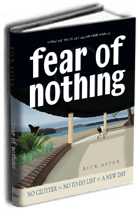March of Trash asks you to take action on clutter every day for a month.
There is a side of decluttering that is so problematic that I hardly ever mention it — but now is the time.
When you share a space with multiple other people — which usually means your family — ambiguous situations can arise around some of the stuff in the space. Whose stuff is it? You can’t always tell by looking at something who owns it or whose responsibility it is. When this happens, the easiest course of action is to leave the stuff generally where it is. Over time, this stuff can build up.
This can be difficult to solve because the best answer, as labor-intensive as it is, is to get everyone together to share information and come to a resolution around each area of ambiguity. That could require having the whole family at home at the same time, with time to spare — but what disaster would ever make those conditions come about?
Well, actually, any disaster that isn’t so damaging that the lights go out has that potential. The more boring a disaster is, the more likely it is that everyone will agree to spend some time looking at clutter. The current global disaster, a pandemic that has millions of families isolating at home, is almost tailor-made for a clutter-clearing initiative.
There is no need to be afraid of having to mediate a series of heated disputes in which two people claim an interest in the same stuff and can’t agree on what should be done with it. That could happen, but it is the rare exception, and when it occurs, it can be left for later. It is more important to get through the usual situation around ambiguous clutter, which is that no one is entirely sure how the situation came about and no one has strong opinions or is particularly eager to take ownership of the things involved. After coming to a collective understanding of what is there, those things can be cleared away in one way or another.
Imagine, as an example, a partially assembled jigsaw puzzle that has been languishing for a week. It may be that one person volunteers to complete the puzzle. Afterward, the completed puzzle can be left on the table for most of a day so that everyone can admire it, and then put away.
It is common enough that no one has any idea where an item came from or why it is there. It might not even belong to anyone in the family. Or perhaps its owner is in the room but doesn’t remember bringing it home. A visitor might have left it behind. Regardless of the details, as soon as everyone has shared their knowledge and opinions about an item, it is usually easy to come to a consensus about where the item should go next.
If time is not pressing, then it is important to respect everyone’s emotional limits around clutter clearing. The person who is most eager to clear away the clutter is rarely the one whose eyes are glazing over after ten minutes. Instead of pushing those who are in distress to carry on until the work is done or someone has a traumatic breakdown, it is better to bring things to a stop relatively soon after someone is seized with fatigue or emotional resistance. I would rather see a family go through their ambiguous clutter in twelve ten-minutes sessions spread out over three weeks than in an intensive half-day ordeal in which one person has to drag the more reluctant participants through an increasingly difficult process punctuated by complaints and arguments. The short sessions are more productive in any case.
Be patient, but find a way to clarify the ambiguous clutter in the house when the opportunity arises. Living a life surrounded by clutter that no one can do anything about can eventually lead to feelings of helplessness around life in general. Everyone will feel better with that part of the clutter taken away.



No comments:
Post a Comment